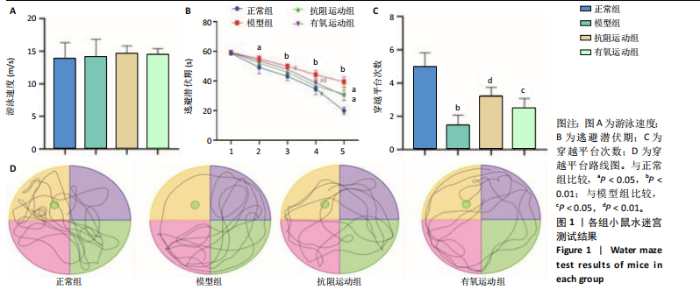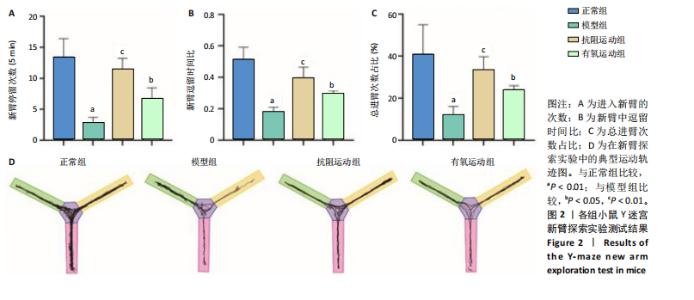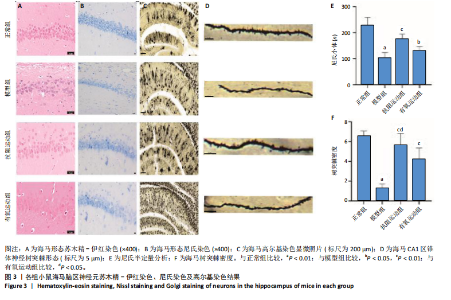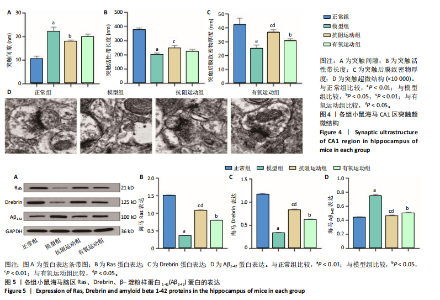Chinese Journal of Tissue Engineering Research ›› 2025, Vol. 29 ›› Issue (26): 5528-5535.doi: 10.12307/2025.761
Previous Articles Next Articles
Effects of aerobic or resistance exercise on hippocampal ras/Drebrin dendritic spine plasticity in a mouse model of Alzheimer’s disease
He Ningjuan, Li Li, Wang Su, Yang Jianshe, Lei Siyun, Wang Yang
- Harbin Sport University, Harbin 150006, Heilongjiang Province, China
-
Received:2024-08-01Accepted:2024-10-11Online:2025-09-18Published:2025-02-20 -
Contact:Li Li, PhD, Doctoral supervisor, Professor, Harbin Sport University, Harbin 150006, Heilongjiang Province, China -
About author:He Ningjuan, Master’s candidate, Harbin Sport University, Harbin 150006, Heilongjiang Province, China -
Supported by:Harbin Sport University Doctoral Talent Research Start-up Fund Project, No. RCYJ-2113 (to LL)
CLC Number:
Cite this article
He Ningjuan, Li Li, Wang Su, Yang Jianshe, Lei Siyun, Wang Yang. Effects of aerobic or resistance exercise on hippocampal ras/Drebrin dendritic spine plasticity in a mouse model of Alzheimer’s disease[J]. Chinese Journal of Tissue Engineering Research, 2025, 29(26): 5528-5535.
share this article
Add to citation manager EndNote|Reference Manager|ProCite|BibTeX|RefWorks

2.1 实验动物数量分析 实验选用APP/PS1双转基因30只,C57BL/6J小鼠10只,实验过程中无脱失,全部进入结果分析。 2.2 水迷宫实验结果 Morris水迷宫定位巡航实验显示,各组小鼠之间的游泳速度无明显差异(P > 0.05),见图1A;表明游泳速度不会影响各组小鼠之间的逃避潜伏期差异。 随着训练时间的增加,各组小鼠逃避潜伏期总体呈现下降趋势。从学习阶段第2天开始,与正常组对比,模型组小鼠连续5 d逃避潜伏期延长(P < 0.05,P < 0.01);与模型组对比,抗阻运动组和有氧运动组小鼠连续5 d逃避潜伏期缩短(P < 0.05,P < 0.01);与有氧运动组对比,抗阻运动组小鼠连续5 d逃避潜伏期无明显差异(P > 0.05),见图1B;说明抗阻运动或有氧运动均可以有效改善小鼠的学习记忆能力。 空间探索结果显示,与正常组对比,模型组小鼠穿越平台次数均减少(P < 0.01);与模型组相比,抗阻运动组和有氧运动组小鼠穿越平台次数均有所增加(P < 0.05,P < 0.01);与有氧运动组对比,抗阻运动组小鼠穿越平台次数无明显差异(P > 0.05),见图1C,D。 2.3 Y迷宫实验结果 Y迷宫新臂探索实验的结果显示,与正常组比较,模型组小鼠进入Y迷宫新臂的次数显著减少(P < 0.01);与模型组比较,抗阻运动组和有氧运动组小鼠进入Y迷宫新臂的次数明显增加(P < 0.05,P < 0.01);与有氧运动组对比,抗阻运动组小进入Y迷宫新臂的次数无明显差异(P > 0.05),见图2A。 与正常组比较,模型组小鼠在新臂的探索时间缩短(P < 0.01);与模型组比较抗阻运动组和有氧运动组小鼠在新臂的探索时间明显延长(P < 0.05,P < 0.01);与有氧运动组对比,抗阻运动组小鼠在新臂的探索时间无明显延长(P > 0.05),见图2B。 此外,与正常组相比较,模型组小鼠总进臂次数明显减少(P < 0.01),与模型组比较抗阻运动组和有氧运动组小鼠总进臂次数明显增加(P < 0.05,P < 0.01),与有氧运动组对比,抗阻运动组总进臂次数无明显差异(P > 0.05),见图2C。每组小鼠在新臂探索实验中的典型行动路线图见图2D。 2.4 苏木精-伊红/尼氏/高尔基染色结果 见图3。 2.4.1 苏木精-伊红染色观察海马神经元细胞的形态变化 正常组小鼠海马内CA1区锥体细胞排列紧密有序,结构完整,未见细胞形态发生明显病理改变。模型组小鼠海马内神经元细胞排列紊乱,核皱缩甚至破坏,细胞间隙明显增大,数量减少。抗阻运动组和有氧运动组小鼠海马CA1区神经元排列为整齐,核损伤数量较少,神经元形态较为完整,见图3A。 2.4.2 尼氏体观察神经元细胞损伤情况 正常组小鼠海马区神经元排列整齐致密,形态规则,且神经元内尼氏体丰富,镜下多为标准的虎斑状或点状;模型小鼠海马区神经元排列紊乱、细胞之间的间隙较大,尼氏体数量明显减少;与模型组对比,抗阻运动组和有氧运动组小鼠海马区神经元形态均有所改善,排列较为整齐,尼氏体数量增多,染色加深,见图3B。与正常组相比较,模型组小鼠海马CA1区胞质内尼氏体数量明显减少(P < 0.01);与模型组比较,抗阻运动组和有氧运动组海马CA1区胞质内尼氏体数量明显减少(P < 0.01,P < 0.05);与有氧运动组对比,抗阻运动组海马CA1区胞质内尼氏体数量无明显差异(P > 0.05),见图3E。 2.4.3 高尔基染色观察海马神经元及树突棘的形态结构 正常组小鼠海马CA1区树突棘分布整齐密集,边缘完整;模型组小鼠海马CA1区神经元树突分支少,树突棘密度显著减少(P < 0.01);抗阻运动组和有氧运动组小鼠海马CA1区神经元树突棘形态较为规则,密度显著增加(P < 0.01),分布较为复杂,见图3C;与有氧运动组对比,抗阻运动组小鼠神经元树突棘密度增加(P < 0.05),见图3D,F。结果说明,抗阻运动和有氧运动均可改善APP/PS1小鼠海马神经元树突损伤,且抗阻运动的改善效果更好。 2.5 各组小鼠海马CA1区突触超微结构变化 见图4。突触是神经元之间传递信息和形成记忆的结构基础,电子透射显微镜观察结果发现,正常组小鼠海马CA1区突触结构完整、数量多;模型组小鼠海马CA1区突触数量明显减少、突触前膜与突触后膜分界线清晰度欠佳、突触活性带长度变短和突触后膜致密物减少,突触连接结构紊乱;抗阻运动组和有氧运动组小鼠海马CA1区突触数量增加,突触间隙缩短、突触有效长度增加,见图4D。 与正常组对比,模型组小鼠海马CA1区突触间隙显著变大(P < 0.01);与模型组相比,抗阻运动组小鼠CA1区突触间隙明显减少(P < 0.05),有氧运动组小鼠突触间隙变化差异无显著性意义(P > 0.05);与有氧运动组相比,抗阻运动组小鼠海马CA1突触间隙变化差异无显著性意义(P > 0.05),见图4A。 与正常组对比,模型组小鼠海马突触活性带长度显著变短(P < 0.01);与模型组相比,抗阻运动组小鼠突触活性带长度明显增加(P < 0.05);有氧运动组小鼠突触活性带长度变化差异无显著性意义(P > 0.05);与有氧运动组相比,抗阻运动组小鼠海马CA1突触活性带长度变化差异无显著性意义(P > 0.05),见图4B。 与正常组对比,模型组小鼠海马突触后膜致密物厚度显著下降(P < 0.01);与模型组相比,抗阻运动组和有氧运动组小鼠突触后膜致密物厚度显著增多(P < 0.01,P < 0.05);与有氧运动组相比,抗阻运动组小鼠突触后膜致密物明显增多(P < 0.05),见图4C。 2.6 Western Blot结果 进一步通过Western Blot检测各组小鼠海马组织中β-淀粉样蛋白1-42蛋白、Ras蛋白和Drebrin蛋白表达,见图5A。 与正常组对比,模型组小鼠海马Ras和Drebrin蛋白表达量降低(P < 0.01);与模型组相比,抗阻运动组和有氧运动组小鼠海马Ras和Drebrin蛋白表达量升高明显(P < 0.05,P < 0.01);与有氧运动组对比,抗阻运动组小鼠Ras和Drebrin蛋白表达量升高明显(P < 0.05),见图5B,C。 与正常组对比,模型组小鼠海马β-淀粉样蛋白1-42蛋白表达量升高(P < 0.01);与模型组相比,抗阻运动组"

| [1] LANE CA, HARDY J, SCHOTT JM. Alzheimer’s disease. Eur J Neurol. 2018;25(1):59-70. [2] 阳金鑫, 王坤, 赵静, 等. 有氧运动干预对阿尔茨海默患者突触可塑性的影响[J].中国组织工程研究,2022,26(26):4216-4223. [3] Guo H, Ali T, Que J, et al. Dendritic spine dynamics in associative memory: A comprehensive review. FASEB J. 2023;37(5):e22896. [4] HERING H, SHENG M. Dendritic spines: structure, dynamics and regulation. Nat Rev Neurosci. 2001;2(12):880-888. [5] SIKORA E, BIELAK-ZMIJEWSKA A, DUDKOWSKA M, et al. Cellular Senescence in Brain Aging. Front Aging Neurosci. 2021;13:646924. [6] MAJOUL I, SHIRAO T, SEKINO Y, et al. Many faces of drebrin: from building dendritic spines and stabilizing gap junctions to shaping neurite-like cell processes. Histochem Cell Biol. 2007;127(4):355-361.
[7] 谢梅, 徐平. Drebrin参与树突棘发育及认知功能形成的研究进展[J].中国医药导报,2021,18(4):37-40. [8] DOWNWARD J.Targeting RAS signalling pathways in cancer therapy. Nat Rev Cancer. 2003;3(1):11-22. [9] RUMBAUGH G, ADAMS JP, KIM JH, et al. SynGAP regulates synaptic strength and mitogen-activated protein kinases in cultured neurons.Proc Natl Acad Sci U S A. 2006;103(12):4344-4351. [10] NISHIYAMA J.Plasticity of dendritic spines: Molecular function and dysfunction in neurodevelopmental disorders. Psychiatry Clin Neurosci. 2019;73(9):541-550. [11] BIOU V, BRINKHAUS H, MALENKA RC, et al. Interactions between drebrin and Ras regulate dendritic spine plasticity. Eur J Neurosci. 2008;27(11):2847-2859. [12] 梁隆钰, 卢蕊, 张燕, 等. 有氧和抗阻运动经IL-18/IL-18R通路对SAMP8小鼠抗皮肤老化的作用研究[J]. 中国病理生理杂志,2024, 40(4):713-721. [13] 程美佳, 袁常斌, 鞠业涛, 等. 涤痰汤通过调节IKB/NF-κB通路和细胞凋亡抑制阿尔茨海默病小鼠Tau蛋白过度磷酸化[J]. 时珍国医国药,2024,35(2):270-274. [14] DE LA ROSA A, OLASO-GONZALEZ G, ARC-CHAGNAUD C, et al. Physical exercise in the prevention and treatment of Alzheimer’s disease. J Sport Health Sci. 2020;9(5):394-404. [15] 王斌, 赵仁清, 赵晨, 等.凋亡介导运动改善阿尔茨海默病的研究进展[J].中国老年学杂志,2024,44(8):2038-2044. [16] HASHIGUCHI D, CAMPOS HC, WUO-SILVA R, et al. Resistance Exercise Decreases Amyloid Load and Modulates Inflammatory Responses in the APP/PS1 Mouse Model for Alzheimer’s Disease. J Alzheimers Dis. 2020;73(4):1525-1539. [17] LIU Y, CHU J, YAN T, et al. Short-term resistance exercise inhibits neuroinflammation and attenuates neuropathological changes in 3xTg Alzheimer’s disease mice. J Neuroinflammation. 2020;17(1):4. [18] NAVARRO V, SANCHEZ-MEJIAS E, JIMENEZ S, et al. Microglia in Alzheimer’s Disease: Activated, Dysfunctional or Degenerative. Front Aging Neurosci. 2018;10:140. [19] LIU HL, ZHAO G, ZHANG H, et al. Long-term treadmill exercise inhibits the progression of Alzheimer’s disease-like neuropathology in the hippocampus of APP/PS1 transgenic mice. Behav Brain Res. 2013;256:261-272. [20] 付蕊, 徐桂芝, 朱海军, 等. 经颅磁刺激对学习记忆及大脑神经突触可塑性影响的研究进展[J]. 生物医学工程学杂志,2021,38(4): 783-789. [21] YEUNG JH, KWAKOWSKY A. Metabotropic glutamate receptor 1 alpha: a unique receptor variant with variable implications for Alzheimer’s disease pathogenesis. Neural Regen Res. 2023;18(10):2196-2197. [22] 李月, 张莉莉, 赵灿, 等. ERβ/JNK通路介导的杜仲提取物对APP/PS1双转基因小鼠学习记忆能力的影响[J]. 中国中药杂志,2025, 50(2):285-293. [23] 齐妍强, 叶红霞, 王妍又, 等. 红花黄色素对SCOP诱导小鼠认知功能损伤的保护作用[J].中国药理学通报,2024,40(10):1858-1865. [24] Olsson B, Lautner R, Andreasson U, et al. CSF and blood biomarkers for the diagnosis of Alzheimer’s disease: a systematic review and meta-analysis. Lancet Neurol. 2016;15(7):673-684. [25] John A, Reddy PH. Synaptic basis of Alzheimer’s disease: Focus on synaptic amyloid beta, P-tau and mitochondria. Ageing Res Rev. 2021;65:101208. [26] Dailey ME, Smith SJ. The dynamics of dendritic structure in developing hippocampal slices. J Neurosci. 1996;16(9):2983-2994. [27] Aoki C, Sekino Y, Hanamura K, et al. Drebrin A is a postsynaptic protein that localizes in vivo to the submembranous surface of dendritic sites forming excitatory synapses. J Comp Neurol. 2005;483(4):383-402. [28] Zhong J. RAS and downstream RAF-MEK and PI3K-AKT signaling in neuronal development, function and dysfunction. Biol Chem. 2016; 397(3):215-222. [29] Harvey CD, Yasuda R, Zhong H, et al. The spread of Ras activity triggered by activation of a single dendritic spine. Science. 2008; 321(5885):136-140. [30] Biou V, Brinkhaus H, Malenka RC, et al. Interactions between drebrin and Ras regulate dendritic spine plasticity. Eur J Neurosci. 2008;27(11):2847-2859. [31] 顾博雅, 高姗姗, 赵丽.有氧运动对调节AD模型小鼠海马Ras/Drebrin增加树突棘可塑性分析[J]. 北京体育大学学报,2020, 43(1):126-133. [32] 柴继侠, 姚君茹, 于剑锋, 等. Drebrin和SYP在APP/PS1转基因AD小鼠海马内的表达与认知障碍的关系[J]. 神经解剖学杂志, 2009,25(3):273-278. |
| [1] | Xu Biao, Lu Tan, Jiang Yaqiong, Yin Yujiao. Xu Biao, Lu Tan, Jiang Yaqiong, Yin Yujiao [J]. Chinese Journal of Tissue Engineering Research, 2025, 29(9): 1768-1774. |
| [2] | Wang Xuanqiang, Zhang Wenyang, Li Yang, Kong Weiqian, Li Wei, Wang Le, Li Zhongshan, Bai Shi. Effects of chronic exposure to low-frequency pulsed magnetic fields on contractility and morphology of the quadriceps muscle in healthy adults [J]. Chinese Journal of Tissue Engineering Research, 2025, 29(8): 1634-1642. |
| [3] | Zhang Mingyang, Yang Xinling. Verbascoside inhibits Erastin-induced ferroptosis of dopaminergic nerve cell line MN9D cells [J]. Chinese Journal of Tissue Engineering Research, 2025, 29(7): 1408-1413. |
| [4] | Lu Jieming, Li Yajing, Du Peijie, Xu Dongqing. Effects of artificial turf versus natural grass on biomechanical performance of the lower limbs in young females during jump-landing [J]. Chinese Journal of Tissue Engineering Research, 2025, 29(6): 1101-1107. |
| [5] | Zhao Xiaoxuan, Liu Shuaiyi, Li Qi, Xing Zheng, Li Qingwen, Chu Xiaolei. Different exercise modalities promote functional recovery after peripheral nerve injury [J]. Chinese Journal of Tissue Engineering Research, 2025, 29(6): 1248-1256. |
| [6] | Xiong Bohan, Wang Guoliang, Yu Yang, Xue Wenqiang, Yu Hong, Liu Jinrui, Ruan Zhaohui, Li Yajuan, Liu Haolong, Dong Kaiyan, Long Dan, Chen Zhao. Internal tension relieving technique assisted anterior cruciate ligament reconstruction to promote ligamentization of Achilles tendon grafts in small ear pigs in southern Yunnan province [J]. Chinese Journal of Tissue Engineering Research, 2025, 29(4): 713-720. |
| [7] | Wang Kairu, Fu Shizhe, Li Jiahui, Yan Ru, Ma Yuru, Shi Bo, Ye Congyan , Yan Rui, Cong Guangzhi, Jia Shaobin. Spermidine/spermine N1-acetyltransferase 1 participates in vascular smooth muscle cell calcification [J]. Chinese Journal of Tissue Engineering Research, 2025, 29(32): 6836-6842. |
| [8] | Lin Shuqian, Zhao Xilong, Gao Jing, Pan Xinghua, Li Zian, Ruan Guangping. Comparison of biological characteristics of mouse bone marrow mesenchymal stem cells after interference and overexpression of telomere Cajal body protein-1 [J]. Chinese Journal of Tissue Engineering Research, 2025, 29(31): 6616-6624. |
| [9] | Wang Jiaqian, , Jiang Changjun, Peng Yi, Ma Mi, Li Junhan. Study on the role of aerobic exercise in regulating the CNPY2-mediated AKT/GSK3β pathway for improving non-alcoholic fatty liver [J]. Chinese Journal of Tissue Engineering Research, 2025, 29(30): 6441-6448. |
| [10] | Hou Licun, Hu Kai, Shao Yiran. Methods and effects on endotoxin removal in allogeneic bone [J]. Chinese Journal of Tissue Engineering Research, 2025, 29(28): 5985-5993. |
| [11] |
Wang Qianliang, Zhang Qianzhongyi, Peng Yujian, Yan Jun.
Effects of unilateral biportal endoscopic transforaminal lumbar interbody fusion on paraspinal muscles
[J]. Chinese Journal of Tissue Engineering Research, 2025, 29(27): 5862-5868.
|
| [12] | Zhang Juanjuan, Jiang Nannan, Wu Yajun, Gu Qian, He Linfei, Ji Yongxin, Liu Su. Schroth therapy combined with core strength training improves scoliosis angle in patients with mild adolescent idiopathic scoliosis [J]. Chinese Journal of Tissue Engineering Research, 2025, 29(27): 5876-5882. |
| [13] | Liu Jiashun, Xie Hongru, Sun Yunkai, Li Shujin, Mao Tengfei, An Yaoyao, Zhang Qin. Correlation and mechanism between lumbar disc degeneration and paraspinal muscle changes [J]. Chinese Journal of Tissue Engineering Research, 2025, 29(27): 5897-5906. |
| [14] | Zhao Peng, Wang Congcong, Wang Chenyu. Effect of aerobic exercise on mobilization and function of endothelial progenitor cells in patients with myocardial infarction [J]. Chinese Journal of Tissue Engineering Research, 2025, 29(23): 4947-4955. |
| [15] | Zilalai · Julaiti, Mawulanjiang · Abudurenmu, Aikeliya · Ainiwaer, Reyila · Kuerban, Nijiati · Tuersun. Finite element analysis of ultrashort implants applied to the mandibular posterior tooth area under different bone conditions [J]. Chinese Journal of Tissue Engineering Research, 2025, 29(22): 4679-4686. |
| Viewed | ||||||
|
Full text |
|
|||||
|
Abstract |
|
|||||





